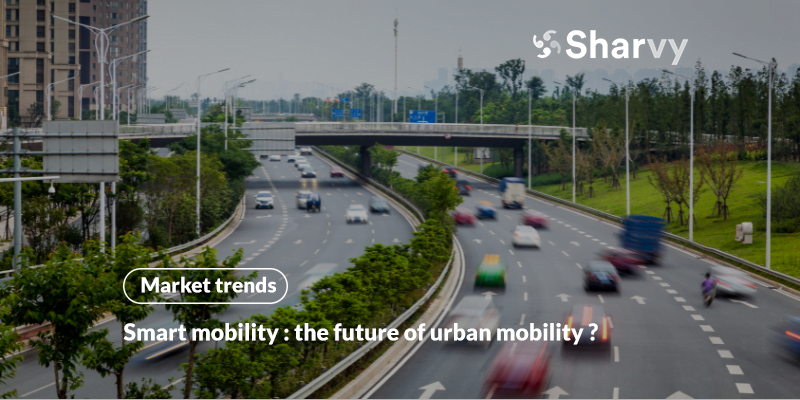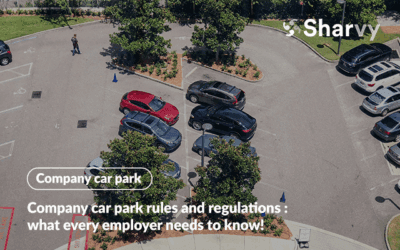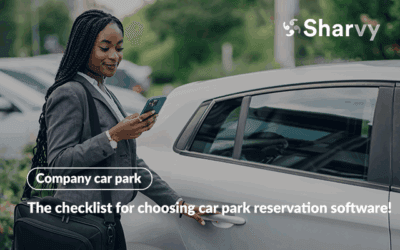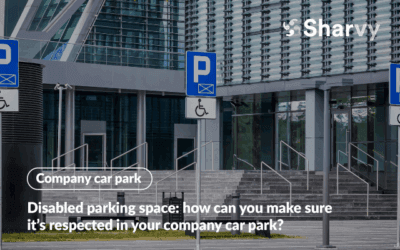For many years, we have been responding to the challenges of a changing world. As a result, population flows are intensifying, and resources are becoming scarcer. Unfortunately, this trend is set to continue. According to the UN, by 2050, more than 70% of the population will live in urban areas. Therefore, this outlook places the issue of urban mobility, particularly smart mobility, as one of the main challenges of tomorrow’s world.
The objective now is to reconcile everyone’s needs in terms of mobility while reducing CO2 emissions to move towards more sustainable mobility. There are many ways to think about this… However, at the heart of these issues, the concept of smart mobility is a promising path! Focus on it in this article.
To begin, what is smart mobility?
Smart mobility is a promising concept that has gained momentum recently. It can be defined as intelligent, connected, and more sustainable mobility. Its objective is twofold : to make users’ journeys smoother and more efficient while making them safer and more sustainable.
To achieve this, smart mobility relies on NICT (New Information and Communication Technologies), whose rapid development offers attractive opportunities ! These various technological innovations allow users to obtain real-time services adapted to their needs.
The result ? Urban mobility fills the efficiency gap. But also one that offers a better experience to all users.
But how is it being implemented ? What are the identifiable solutions & how can you take part in them ?
To understand this concept, it is essential to note that smart mobility includes new practices and uses built over time. Let’s discover some examples below !
1. Smart mobility, a concept that aims to improve accessibility !
It is clear that today, mobility offers are unevenly distributed, and the potential to move is not the same for all citizens.
Indeed, at the center of the inequalities, we can mention daily mobility as one of the most constraining for many people. For example, going to work, taking one’s children to school, shopping, or meeting friends in the city center. These are simple and harmless trips for many people. However, for other people, this is a great difficulty. This is particularly true for seniors, the visually impaired, and people with reduced mobility.
At this point, it is essential to remember that the latter’s difficulty will increase as soon as a user feels any constraint in his travels. In correlation, his choice is likely to be oriented towards the non-realization of his activity. In particular, since it represents a difficult experience.
Therefore, mobility must be able to take new forms ! In particular, through alternative, multiple and collective mobility offers. On this point, smart mobility already provides various solutions, promoting inclusive mobility. For example, by offering solutions designed for everyone to improve travel, accessibility, and parking for people with reduced mobility (visually impaired, wheelchair users, etc.).
2. A concept that accelerates soft mobility !
First, let’s briefly recall what “soft mobility” means. This concept includes all modes of travel considered compatible with sustainable mobility. Examples: carpooling, carsharing, electric bikes, and scooters. But also public transport (bus, streetcar, train, etc.).
Smart mobility is also taking the lead by redefining the classic approach to urban mobility. In particular, to promote and accelerate soft mobility.
However, it seems to be built as uses and innovations progress. Today, it is up to companies, urban planning professionals, and local authorities to take various actions to achieve this objective. For example, develop public spaces but also infrastructures and roads. This is to create a safe environment adapted to these new needs.
Thus, the objective is to make traffic flow more smoothly, reinforce users’ safety, move towards more gentle mobility, and solve parking problems!
3. Smart mobility optimizes parking
Parking is a recurring issue for many users. Whether in urban areas or in company parking lots. The time needed to find a parking space represents as much time lost as pollution emitted by the vehicle. Yet, at the same time, it is a source of daily stress and anxiety.
It is, therefore, essential to rethink the uses of parking spaces to reconcile the need to free up space with the parking needs of a user.
In essence, smart mobility calls on a wide range of fields and expertise in this area. Indeed, various companies and startups are tackling these parking problems and proposing innovative and connected solutions.
Among these solutions, Sharvy can be cited! Via a web & mobile application, and in just a few clicks, the parking policy of any company can be optimized, and the employee experience improved. For example, employees can reserve a parking space in advance of their departure or release it if they are holders when they are absent. This way, Sharvy helps ensure that company parking lots are filled to capacity while promoting mobility.
Want to know more about it? It’s right here!
4. Multimodal management is also facilitated
On the other hand, when we talk about smart mobility, we regularly hear about multimodal management. In recent years, it has become more and more popular. This is because it allows a single person to use several modes of transport for the same journey. It includes cars, public transport, bicycles, and even pedestrian routes.
The aim is to make people’s journeys more efficient and more flexible. But also to take advantage of emerging technologies to adopt new travel habits via existing transport. On the one hand, more ecological (by promoting carpooling, for example) and has a positive social impact.
For example, let’s remember that today, carpooling represents only 3% of daily trips. Therefore, to improve usage, startups and large companies are choosing to innovate. In this line, we can mention creating a common interface between the Sharvy application and KAROS. From now on, drivers conclude they’re carpooling in the KAROS application. Then, a company parking space is automatically reserved for them in the Sharvy app.
This way, the user experience is improved, facilitated, and more consistent. This is an excellent example of smart and shared mobility!
5. Smart mobility for urban safety
Finally, we should remember that urban mobility must also support the appropriation of new technologies to improve urban safety. This is achieved by exploiting the opportunities offered by megadata and IoT systems. Today, we can already see great advances in this regard, and they have gradually integrated into the infrastructure of cities. Notably :
➢ Smart pavements monitor weather conditions, road conditions, and wear and tear. The information collected is distributed to all users. This can be done directly via their smartphone using a dedicated application or connected panels installed at strategic points in the city.
➢ Smart parking lots indicate the available spaces to users and the type of space (PRM, bicycles, motorcycles, with an electric terminal, etc.). This will optimize the current management of parking lots and improve their occupancy rate.
➢ Intelligent traffic lights reduce traffic jams by adjusting to traffic conditions.
➢ Smart cameras that constantly monitor the city. These cameras can send alerts directly to the relevant authorities in case of problems.
Therefore, these technologies can anticipate and reduce traffic jams, improve traffic and urban safety, and enable better mobility for all citizens.
However, these examples are not exhaustive! Innovations on this subject are constantly multiplying. As time goes by, these innovations will work more and more in synergy. This will transform passive urban traffic management into intelligent and active management.
What are the advantages of promoting smart mobility in companies ?
Today, daily commuting, such as “home to work,” is an important part of tomorrow’s urban mobility. This is why companies need to be aware of this, as they can positively impact the future of mobility.
For these companies, this is an opportunity to adopt an authentic Corporate Social Responsibility (CSR) approach. On the one hand, it will improve the Quality of Life at work of its employees, but also their productivity. On the other hand, encouraging its employees to rethink the way they travel and offering them various solutions (Sustainable Mobility Package, intelligent and connected company parking lot) contributes to improving their daily lives.
At the same time, it is an opportunity to optimize costs. In particular, parking costs and the occupancy rate of its parking lot – or multi-site parking lots – by using dedicated technologies, such as Sharvy. However, it also contributes to reducing road traffic and the risk of road accidents and encourages soft mobility.
Finally, let’s not forget that promoting smart mobility sends an image of a committed and responsible company. In this way, it greatly enhances its image as a company that cares about its employees and the environment and improves its employer brand!
Have a question? Check the FAQ!
What are the possible obstacles to the development of smart mobility?
It will be increasingly difficult to meet users’ expectations in terms of mobility. Various obstacles can be identified: citizens’ reluctance and rejection of new technologies, economic and legal environment to be adapted, questions about data and its processing, etc. However, daily efforts are made in this respect. Thus, it is up to each of us: citizens, companies, communities, and public authorities, to act and change our behavior to adapt our daily life to these evolutions. The objective is now to build a more intelligent, autonomous, and responsible world, despite the obstacles we may encounter, solutions are emerging every day.
What are the advantages of smart mobility for employees?
The benefits of smart mobility for employees are numerous. On the one hand, it reduces stress and daily fatigue. Indeed, the commute to work is optimized and reduced. At the same time, access to an intelligent company parking lot, followed by the implementation of a parking policy, makes it easier for employees to come to work. For example, they also waste less time finding a parking space each morning. Finally, the costs associated with transportation are reduced since they favor soft mobility (bicycles, carpooling, carsharing, etc).
How can companies encourage the adoption of smart mobility among their employees?
Companies can encourage the adoption of smart mobility among their employees by implementing initiatives such as subsidizing electric vehicles, creating secure bike lanes near the workplace, or facilitating access to alternative transportation options like shared scooters and bikes. They can also promote collective transportation solutions and carpooling while adopting a sustainable mobility policy integrated into their CSR strategy. Implementing effective intermodality and encouraging the use of more environmentally friendly mobility services in urban areas can also play a key role in reducing polluting urban commutes.
Want to learn more? Check out our latest articles!
Company car park rules and regulations: what every employer needs to know!
Discover the essential company car park rules and regulations in the UK and ensure your business stays safe, accessible, and compliant.
The checklist for choosing car park reservation software!
How do you choose car park reservation software for your business? What features should you choose? The answers are right here.
Disabled parking space: how can you make sure it’s respected in your company car park?
Why and how can you ensure the availability of a disabled parking space in your company car park? Discover practical advice and solutions.
Subscribe to our newsletter!
PARKING & WORKPLACE MANAGEMENT SOLUTION
Car park management - Charging points monitoring - Desk booking - Booking by time slots
SUBSCRIBE TO THE NEWSLETTER
Receive the latest Parking & Workplace trends by email once a month.













